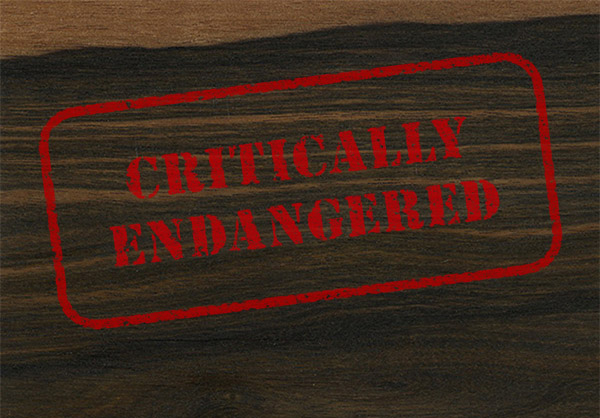
Whether conscious of it or not, just about the entire world loves dark colored woods—and the darker, the better. So, what happens when you mix a strong global demand with small and slow-growing trees?
Issues.
Consider these words by the co-founder of Taylor Guitars in his talk on ebony back in 2012, who articulates the issue very well:
“Ebony has been a wood that for two, or three, or four hundred years, we’ve gone into countries, and we’ve used the ebony until it’s all gone. Literally. Then we move into another country, and we take their ebony till it’s all gone. Why do I say ‘we’?—because ebony isn’t cut in Africa for use by Africans. Ebony is cut in Africa to be sold to people like us, to make things like guitars out of. That’s the simple truth of the matter.”
-Bob Taylor
Why should I care?
Maybe you shouldn’t. But at the very least, everyone who buys, uses or makes ebony wood products should be aware of the situation, and make informed, conscientious decisions. Maybe you’ve only used a little bit of ebony here and there, but just remember this: the world is filled with small bits and pieces of ebony. This is precisely what ebony is used for. No one is going to make an enormous office table out of solid ebony, but that same office table may very well feature a custom inlay made of ebony. More often than not, ebony is used bit by bit, and you might be the one using that next bit.
(On a personal note, I am a woodworker myself, and yes, I have bought and used ebony for a variety of projects in the past. Was I aware of the scope of the situation surrounding ebony at the time? No. Knowing what I know now, would I still buy and use ebony? Maybe… but I would definitely think twice before I went ahead with it for a project. See alternatives below.)
The Issue
The issue isn’t rocket science: ebony trees (in the Diospyros genus) are generally small and slow growing. Demand for ebony wood is very high: it’s a high quality hardwood that’s very hard, very strong, and most of all, very black. Low supply and high demand means prices go way up. These high prices, coupled with the fact that a lot of the world’s ebony grows in third-world countries, only exacerbates the problem. (Take, for example, the illegal logging that occurred in Madagascar, especially in the early 2000s, where people were literally risking life and limb to get rosewood and ebony logs smuggled out from protected national parks.)
Ideally, most modern industrialized nations harvest wood in such a way that it is sustainable. Certain areas are logged at certain rates to ensure that there will still be trees around to harvest and use for tomorrow. But given ebony’s slow growth rate, and the current rate of harvest, it’s easy to see why there’s a dark outlook for these dark woods.
The Lineup
Let’s take a look at the particular species of ebony and other dark woods and their conservation status:
|
|
||
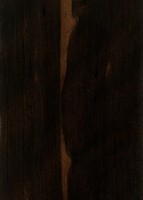 |
Ceylon Ebony (Diospyros ebenum)
STATUS: EXPORTS BANNED Still commonly referred to as Ceylon Ebony because the medium-sized tree reached its best development in Sri Lanka (formerly known as Ceylon). It’s also sometimes referred to as East Indian Ebony or simply Indian Ebony. Although Ceylon Ebony was the original ebony of commerce, it’s seldom available today. This wood species is not listed in the CITES Appendices or on the IUCN Red List of Threatened Species. However, due to exploitation, exporting of this ebony species is restricted in India and Sri Lanka. |
|
|
|
||
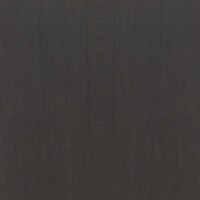 |
Gaboon Ebony (Diospyros crassiflora)
STATUS: ENDANGERED So named because historically most of the wood was exported from the nation of Gabon, though today it’s much more likely to be sourced from Cameroon. Species from Madagascar are listed in the CITES Appendix III, and are on the IUCN Red List. Gabon Ebony is listed as endangered due to a population reduction of over 50% in the past three generations, caused by exploitation. |
|
|
|
||
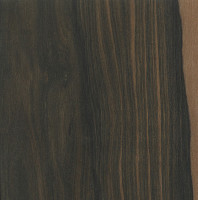 |
Mun Ebony (Diospyros mun)
STATUS: CRITICALLY ENDANGERED One of a handful of ebony species that are native to Asia: more specifically, it’s native to Viet Nam and Laos. Because of exploitation and drastic population reductions, export of this species is currently banned. It is on the IUCN Red List as critically endangered due to a population reduction of over 80% in the past three generations, caused by a decline in its natural range, and exploitation. |
|
|
|
||
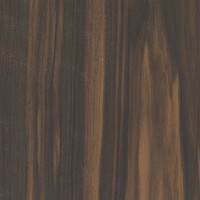 |
Macassar Ebony (Diospyros celebica)
STATUS: VULNERABLE So named for the Indonesian port-city of Makassar, which is one of the primary points of exportation. Being a striped variety of ebony, it is not always considered a direct replacement to African ebony species, and is not considered to be as imperiled as other ebonies. It is on the IUCN Red List as vulnerable due to a population reduction of over 20% in the past three generations, caused by a decline in its natural range, and exploitation. |
|
|
|
||
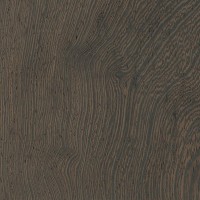 |
Wenge (Millettia laurentii)
STATUS: ENDANGERED Wenge is another African hardwood whose natural range largely overlaps that of Gaboon Ebony. Wenge is not related to ebony, but is a very dark wood that turns nearly black when a finish is a applied, and has been considered as a direct replacement to ebony. It is on the IUCN Red List as endangered due to a population reduction of over 50% in the past three generations, caused by a decline in its natural range, and exploitation. |
|
|
|
||
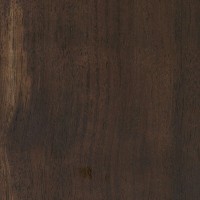 |
Peruvian Walnut (Juglans neotropica)
STATUS: ENDANGERED Perhaps the most fitting name would be Tropical Walnut, yet the term Peruvian Walnut is commonly used among hardwood dealers, even though the wood may not always technically come from Peru. (The name Nogal is also used on occasion, which is Spanish for Walnut.) A number of tropical species in the Juglans genus are on the IUCN Red List. The most notable species, Juglans neotropica, is listed as endangered due to a population reduction of over 50% in the past three generations, caused by a decline in its natural range, and exploitation. |
|
|
|
||
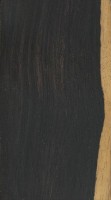 |
African Blackwood (Dalbergia melanoxylon)
STATUS: NEAR THREATENED To be considered the original ebony, African Blackwood was imported and used in Ancient Egypt thousands of years ago. It is reported by the IUCN as being near threatened: technically it doesn’t meet the Red List criteria of a vulnerable or endangered species. However, there’s a great difference between becoming biologically extinct (what the IUCN measures) versus becoming commercially extinct. While not at risk biologically, commercially only ten to twenty percent of mature trees are suitable for exportation, and harvesting is frequently done at an unsustainable rate. |
|
|
|
||
Alternatives
In some instances, the desire to use true ebony makes sense, but in many cases, the usage of ebony is needlessly perpetuated out of tradition or habit. If you’re considering ebony in a project, ask yourself these questions:
Is the section one solid piece of wood? More than likely you could dye/stain another wood black and achieve a similar appearance at a fraction of the cost. Black-dyed veneers can also be a good choice for some applications. Oak can be ebonized using a solution of steel wool and vinegar, and multiple applications of commercial ebony-colored stains are effective on a wide range of woods as well. When you use stains, you open up a lot more wood species options, and have more flexibility in terms of ease-of-workability, weight, and stability (ebony isn’t the most stable wood around). Examples: piano keys, solid wood furniture.
Does it really have to be wood? The very best and highest grades of ebony are jet-black—free from any traces of color variations, perceptible grain patterns, or imperfections—ironically making it identical in appearance to black plastic. (And chances are, most laypeople and customers unfamiliar with ebony will have no appreciation for the real-deal anyway.) In small accent pieces and inlays, there’s a number of alternative materials, such as (drumroll, please…) plastic. Examples: guitar binding, inlay strips, knobs.
Does it really need to be jet-black? This should be the dagger. Unless you’re specifically doing a Holly-on-Ebony, black-and-white contrast piece, another dark-colored wood would probably do a better job than ebony at complementing the existing colors on a wood project. In most cases, no, the wood doesn’t have to be jet-black. Consider some of these alternative woods (listed below) to add texture, pattern, and/or color variation in your next project.
|
|
||
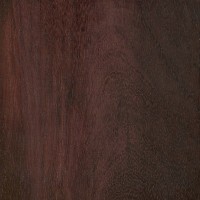 |
Katalox (Swartzia spp.)
This is a diamond in the rough. It usually has a lot of sapwood included in most boards. But if you do the math, it’s a very hard, very dark hardwood that costs a lot less than true ebony, even after you account for the waste from the sapwood. It has a pronounced purplish hue, which contrasts yellowish woods well. |
|
|
|
||
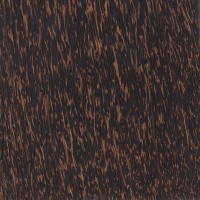 |
Black Palm (Borassus flabellifer)
Black Palm is economical, sustainable, beautiful, and in a lot of instances, would probably serve the same aesthetic function as ebony—and do it in a more organic and natural-looking way. The only downside is that it’s difficult to work with hand or machine tools, and can be very splintery and challenging in its rough, unfinished state. Perfect for single, one-of-a-kind, custom projects. |
|
|
|
||
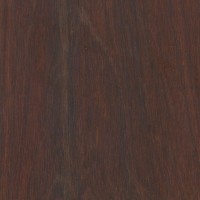 |
Ipe (Handroanthus spp.)
Ipe has a lot of color variation between boards, but darker reddish-brown pieces are available. The wood is dense, strong, and economical, though it does pose challenges in gluing. It’s hard on cutting edges and dulls tools quickly, which should help to give you a behind-the-scenes reminder of what true ebony is really like work with. |
|
|
|
||
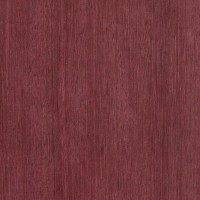 |
Purpleheart (Peltogyne spp.)
There are very dark pieces of Purpleheart available, and the wood becomes even darker once a finish is applied. The vibrant purple color of the wood also tends to darken closer to brown/black with age. Hobbyists have experimented with cooking small pieces of Purpleheart in an oven to naturally darken the color. |
|
|
|
||
 |
Black Walnut (Juglans nigra)
Walnut can lose a lot of color in the kiln-dying process. Air-dried pieces of walnut can have exceptionally rich color with subtle variegations of purple and red mixed within a chocolate-brown background. Not all walnut is created equal, and with a little bit of hunting, some very nice pieces can be found. |
|
|
|
||
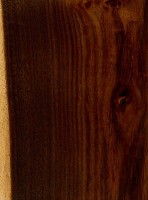 |
Texas Ebony (Ebenopsis ebano)
Texas Ebony can have very dark colors and interesting streaks and grain patterns. However, the wood is quite expensive, and available only in very small sizes. |
|
|
|
||
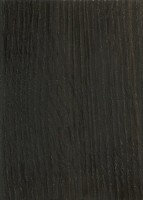 |
Bog Oak (Quercus spp.)
This would be the perfect ebony substitute, except that it’s only produced by natural forces burying the wood in a peat bog for hundreds of years. Given the source (dredged up from swamps), Bog Oak is extremely expensive, and only available in very limited sizes and quantities. |
|
|
|
||
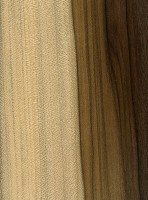 |
Abnormally dark wood: Although not practical on a large-scale production level, many custom furniture makers and other woodworkers would be well served to simply keep their eyes open during their visits to lumberyards and wood suppliers. Spotting some mineral-stained or otherwise abnormally dark wood is a more common occurrence than one might expect. One simple example of this is mineral-stained Yellow Poplar sold at hardware stores, sometimes called Rainbow Poplar. To the left is a picture of Southern Magnolia with some very dark heartwood. | |
|
|
||
Are you an aspiring wood nerd?
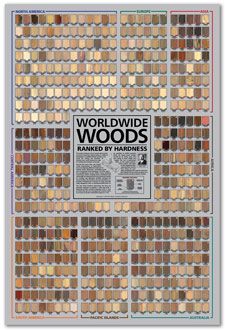




Dear Eric, thank you so much for writing this above. I am a lover of wood and have been making instruments for nearly 30 years, but I always try to look at wood also from the perspective of tree protection, so that future generations have the opportunity to admire these wonderful plants and their wood. Unfortunately, too many people don’t want to know the dark side of the timber trade. Also, many institutions turn a blind eye to illegal trade (which is bringing species to extinction at a terrifying rate). I am very saddened by the fact that large companies… Read more »
I receny found an interesting alternative to ebony … Oak. Specifically oak from slats that were recovered from inside a used wine barrel. Black with the slightest hint of a reddish purple. The color went all through the wood so there is no danger of sanding through the stain. I am suspicious of the strength of the wood but it works well for an accent piece. Attached is an image of a phone holder with the wine oak used.
Another substitute to consider for a black accent is dense, stiff, easy to machine, uniformly black, and cold.
I’m referring to aluminum, anodized black after working.
While I love using more exotic woods in my projects, it saddens me to see how the world wood market is so parasitic. I commend the conservation efforts that are organic, I do not agree with global agencies that swoop down from ivory towers and shut down the commercial aspect of an area in the name of conservation. I can’t imagine how hard an area is hit economically when your entire life has been harvesting your local trees then outsiders shut it all down, then essentially tell you “Learn to code”. Then fly away. This type of practice a good… Read more »
Regarding domestic woods, I think the term is relative. You may not need to restrict yourself only to TX. I’d recommend to anyone in the US or Canada to look into some highly figured walnut. In my opinion, it can be every bit as stunning as exotic imported woods — and usually just as expensive as well!
Hi Bjorn, yes, I like your comment about learning to code lol. can you post a reference to the Greenpeace episode?
It’s great to see how much you people care about wood and forests. I visited a beautiful ebony forest in Mauritius this year where they are doing great work to reverse the ebony deforestation. Anyone who wants to help ebony reforestation efforts in Mauritius have a look at
https://www.ebonyforest.com/
“Since 2006 Ebony Forest has worked to reverse the impacts of habitat degradation and invasive species to create a sanctuary for the island’s unique and rich biodiversity.”
I do a little woodworking- an acquaintance’s husband passed on, and she gave me a bunch of wood blanks…many very dark. Any thoughts on what this might be? No stain applied…just planed. Very dense stuff. Cheers!
It could be ebony, though it might also be a very dark and aged piece of rosewood. Some older pieces of rosewood, when left unfinished (particularly Brazilian rosewood and Bois de Rose) can turn very dark, basically black. If you have worked with either ebony or rosewoods, the scent of the wood can be helpful to compare.
About bog oak: I did my Master’s Degree in Music/Organ Performance at the University of Oregon in Eugene, which has a pipe organ built in Germany in 1972, which used bog oak instead of ebony for the black keys on the manual keyboards. By the time I was a student there when the organ was only ten years old, the bog oak had worn down to quite an uneven surface, in a way that would never have happened with real ebony. The feel was unpleasant and distracting enough for playing that these key coverings were replaced after a few more… Read more »
Yes I live in the U.K. and encounter Bog oak all of the time. It’s cheap here because of its relatively Easy to get in fact burr oak or Oak Burl for our American friends is actually harder to get because all of the big motor and furniture companies buy it up before any can trickle down to us, companies such as Rolls Royce or Bentley, Astin Marten and various cabinet factories. Bog oak is not a hard wearing wood especially compared to any ebony species also because it’s an oak it has tiny imperfections due to the pores which… Read more »
I’m surprised that neither the main article nor the comments mentioned persimmon as an ebony “substitute.” It’s not really a substitute because it’s a true ebony of the genus Diospyros (Diospyros virginiana, among other species). Besides its use as a fruit tree, the wood is used in golf clubs because it’s very hard and strong, and it is sometimes suggested as an ebony alternative in musical instruments. The main impediment to wide use seems to be that there is no dependable supply, and I’ve heard that persimmon fruit tree wood is less dense than wood that is allowed to grow… Read more »
Fumed oak (ammonia from barn animal urine in medieval times) has reached a new level with vacuum processing with turnaround times of 4 to 5 weeks. The more tannin the darker, same chocolate ranges from dark golden brown to almost jet black follow natural grain and flaking patterns. At the moment most oak cut by tree removal companies is chipped or at best used as firewood. Meanwhike, the same white oak in a controlled forest in Germany still produces 600 year old trees six hubdred years adter becoming a managed forest and has fuming in full production. I estimate $15,000… Read more »
Our pear wood in the U.K. is getting harder to source due to demand, there’s an old orchard up the road for me that had hundreds of pear trees and apple trees, it used to be owned by an old cider company that went under in the last finical crisis and the receivers called in the tree surgeons and all of it was chipped the whole orchard. I tried my hardest to buy some pear trees, it took them around a month and a half to butcher this beautiful pear wood. It was worth potentially millions. I tried to tell… Read more »
I sell old woodworking tools and many from 50 to 100 to 150 years old used ebony or rosewood. My concern now is that these can be considered non-saleable due to CITES listing and their history and use may be destroyed with no help in conserving the forests now. I have also had customers visiting countries to find the listed woods now have no economic value so are used as firewood.
If you need really dark thing, use any wood from Prunus genus. Just stain-it-through using the same process as the nature does with bog oak – soak it in iron salts. Depending on initial tannin content in your species, additional pre-soaking in tannin solution may be required. I successfully stained-through samples of cherry plum (Prunus cerasifera) 5 mm (1/3″) thick in just a week and used as a fretboard and pegs (didn’t tried thicker yet). After that you may cut it, carve it and sand it – first it may appear whitish, but when you fine-sanded and polished it, black… Read more »
I just played with ebonizing oak for the first time — using an iron acetate solution left over from de-rusting some old tools, actually — and I’m suitably impressed. Two applications, pretty much just slopped on, and the wood is as close to flat black as I’m ever likely to need. The grain structure remains visible so folks can recognize what you’ve done — but heck, if I didn’t want to see wood grain I’d just paint or piano-laquer the sucker, right?
Our company manufactures thermally modified (roasted) ipe’ that is very black, very dense and very stable. Our biggest market currently is for black tips on gunstocks. I won’t post my contact info, but you can find us if you try.
In Tanzania, villages practice sustainable management of African Blackwood (Dalbergia melanoxylon). Income from the sale of this and other woods goes into community development and back into forest management. They are supported by the Mpingo Conservation and Development Initiative (MCDI). They are FSC certified. Check them out at: https://www.mpingoconservation.org/
I love building guitars, and have often used Wenge especially. Love the look, feel and sound of it, and have never really given it a second thought beyond weather or not my supplier has it in stock, I just jump at the pieces that are most appealing and figured. It’s the same type of process going on in my head as these people who go around killing lions and giraffes just cause it’s a rare and exotic thing. It’s actually extremely selfish. A bit perverted too. That line of thought ends in me today. I am making a conscious and… Read more »
It’s a troubling subject. I made myself a jazz bass with a Madagascar rosewood fretboard bought from a very legitimate source. I later found out about the illegal logging situation and feel a little bit of remorse about it. I wouldn’t want to buy it in the future. I imagine Warwick probably used up half of all available wenge produced in the past 20 years. I think the North American woods will be the way to go as the exotics will eventually all become endangered.
Actually there are many reasons why people shoot giraffes and lions. it may just be a trophy for the rich hunter, but it’s a boon for natives. And also the main reason why animals are thriving in certain areas. We don’t see the same thing with these woods.
HI Chris Im joining you in that strategy. Our domestic hardwoods here in ontario make a pretty sweet guitar. I am working pretty exclusively in local woods now and using the exotics as binding fretboards etc. Its along time since ive seen ceylon ebony or evn a nice piece of Macassar.
D
I’m with you here. I think there is also joy to be had in using old furniture that has been thrown out for Guitars. Not just furniture but anything old that is otherwise for the fire. Where I get a bit out of kilter is the retrospectively applied logic, if something was built years ago, when times were so different its plain daft to make it illegal. At least instruments have purpose, they are not meant to be trophies. Well to some they are I suppose. Numpty collectors.
Pernambuco for violin bows – used for hundreds of years – going extinct – preservation project: https://www.arcosbrasil.com/site/?p=pernambuco
African Blackwood Preservation Project – lots of information – very important for preservation of this species: https://www.blackwoodconservation.org/
Thirty to forty years ago I was rummaging through a bin of trim pieces at a hardwood lumber supply place in Berkeley California when I came across a piece of black wood that was hard as a rock. It appears (yes, I still have it) be a section of either a branch or a trunk of a tree about 4 inches in diameter and 2 1/2 to 3 inches in length. I have always thought of it as ironwood and have never had the appropriate project in which to use it. But this article makes me think it might be… Read more »
This morning I decided to go back and buy the piece of Gabon Ebony I had thought on for 2 days. I need it for a gem tree base, I’m using black tiger eye and clear quartz on. I definitely need black. Then I figured I better do a little research on Ebony. Damn! …I do appreciate the facts you give. Yet it actually hurts me to give it up. (I am surprised to find) BUT I love nature,I care about the state of the Earth,I am a good person, I will do the right thing…As much as it hurts.… Read more »
Don’t give it up. Use it wisely.
I think it would be an awesome investment opportunity for someone to start an ebony tree farm in the tropics. Sort of like Diamond Tropical did with teak.
I could be wrong, but I think one of the biggest obstacles to farming a lot of these endangered species (not just ebony, but also rosewoods too), is that the growth rate is simply too slow for it to be financially worth it. With some in-demand hardwoods like Teak or Mahogany, the growth rate seems to be fast enough to warrant cultivating these trees on plantations. With others, I’m guessing it would take many decades (possibly centuries for some species?) to get to a good harvestable size. In that time, multiple harvests could’ve been done on a faster growing (albeit… Read more »
Only problem is that if you take the value away by reducing the use or desire, many of the loggers will just clear it because it’s in the way.
They only care about what makes them money. Give it value and they may protect it.
Deforestation is another issue altogether. Deforestation mustn’t be used to justify the use of non-sustainable hardwoods; deforestation must end.
Just for info, Bob Taylor now co owns a company in Cameroon that handles between 50-75%+ of the ebony trade there (only country where it’s still really legal). They are concerned with conservation and are in fact cultivating new ebony forests. He’s doing a similar thing in Hawai’i with Koa.
https://www.blackwoodconservation.org/
The problem is less often the woodworker than the client who demands rare and endangered wood species, simply because they are rare and expensive, to feed their egos. But don’t forget architects and designers who specify those woods, because they are fashionable, and they know the names.
Then they need to be educated about it, or the designers should say they are using “blackwood” and leave it at that.
I disagree. The woodworker does very little imho. I have visited some ultra rich houses, literaly and virtually. They are filled to the brim with all sorts of exotic woods. Its not that different…actually its not different at all from ancient times. The more rare something is the more the uber rich seek it out. This is the same as poaching. The average joe doesn’t really care about ivory or a tigers liver . But the super rich especially ones that subscribe to the new age and old age crap that a powedered rhino horn will make you some sort… Read more »